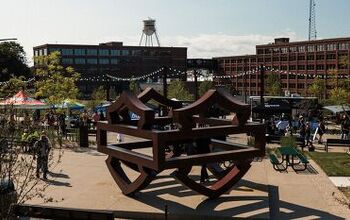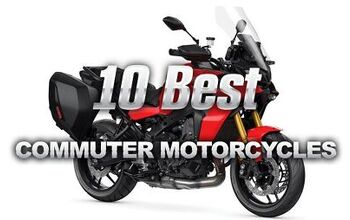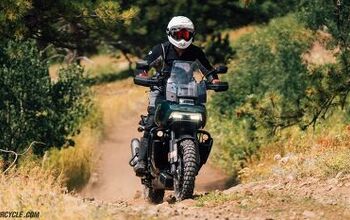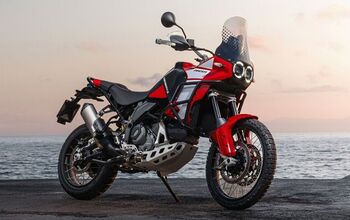What You Need To Know About Automatic Clutch Transmissions

The latest motorcycle industry trend
It wasn’t that long ago that the most popular trend in motorcycle technology was radar-based active cruise control and blindside detection. Today, it’s no longer the hottest trend in the industry, suddenly displaced by a sudden bumper crop of automatic clutch transmission systems.
In the last year, we’ve seen Honda, BMW, KTM, and Yamaha all announcing their own form of automatic clutches, and they likely won’t be the last. Whether you call it E-Clutch, Automated/Automatic Manual Transmission, or Automated Shift Assistant, each of these emergent technologies offer a similar promise: fast shifting without needing to operate a clutch lever.
What’s interesting is that all of these manufacturers have taken a slightly different approach, so it’s not like they are sharing the exact same tech developed by a third party. No, each motorcycle manufacturer has developed its own version, leading to some confusion and misconceptions. We’ll try to clear the air a bit by taking a look at what these systems have in common, but also how they differ.
Don’t Call It A DCT
Reading the feedback to these automated clutches, both here on MO, and across the Internet, I’ve seen a lot of people confusing the technology with dual clutch transmissions. And while DCT and automatic clutch systems have some things in common, the two are quite different. For one thing, all these new competing systems use just a single clutch, and for the most part, the clutch is identical to the existing fully-manual clutches.
A dual clutch transmission, as the name implies, uses two clutches, with one employed for odd-numbered gears (i.e. first, third, and fifth), and the other for even-number gears (second, fourth, and sixth). DCTs are fairly common in automobiles, but implementing them on motorcycles is trickier as you need to package the two clutches and all related parts, while keeping the overall dimensions compact.
Honda worked around the packaging issue by putting one clutch shaft inside the other. The outer shaft connects one clutch to the even gears and the inner shaft connects the other clutch to the odd numbered gears. When you’re riding a Honda DCT motorcycle, you essentially have two gears selected at the same time, but only one clutch is engaged. Gear changes are a simple matter of switching from one clutch to the other.
Overall Honda’s DCT powertrain is still slightly wider than a traditional one, as the clutches are lined up next to each other on one side, but collapsing both clutch shafts into the same space helps keep it all compact enough to fit into a motorcycle chassis. The downside is it’s a lot heavier, as you still have the extra mass of a second clutch, and clutch shaft, plus a larger casing to hold it all together. On a bike like the 2024 Africa Twin, Honda claims a 25-pound weight difference between the DCT and manual transmission models.
How Honda’s E-Clutch Works
Honda was the first to market with this new generation of electronic clutches, debuting the technology on the CB650R and CBR650R. As its name implies, E-Clutch also differs from the offerings from other brands in only automating the clutch, leaving gear changes up to the rider. Honda also left the manual clutch lever intact, allowing riders to ride in a fully manual mode or to override the E-Clutch at any time.
The E-Clutch adds an actuator unit to the right side of the engine. It houses two motors that operate the clutch, disengaging it as needed when the rider initiates a shift using a traditional lever with the left foot. The system takes into account various parameters, including vehicle speed, throttle position, engine speed, shift pedal load, clutch motor reduction gear angle, engine countershaft speed and the current gear position. The bike’s ECU manages the ignition timing and fuel injection systems to compensate as the clutch is engaged, similar to how a quickshifter operates.
Honda also added an operation feel setting to set the level of force required on the shift pedal to signal a change. Riders can independently set upshifting and downshifting between HARD, MEDIUM and SOFT levels.
Honda’s E-Clutch is relatively light, claiming a weight of 4.4 pounds vs the DCT’s 25 pounds, and most notably, it doesn’t require a new engine or transmission. That means Honda can essentially bolt on its E-Clutch to many of its existing motorcycles.
At the moment, Honda’s E-Clutch is not available on U.S.-spec models, but on European models, it adds a €400 (US$438) premium over the price of a regular CB650R or CBR650R. [UPDATE July 23, 2024: American Honda has now announced the CB650R and CBR650R as 2024 models with E-Clutch as standard equipment, but with pricing remaining the same as the 2023 models.]
How BMW’s Automated Shift Assistant Works
Debuting on the new R 1300 GS Adventure, and also on the non-Adventure model for 2025, BMW’s Automated Shift Assistant goes one step further than Honda’s E-Clutch, automating both the clutch and shifting. Unlike Honda, however, BMW opted to completely remove the clutch lever, letting the electronics handle all of the clutch work, but offering both fully-automatic or manual shifting.
In the manual shifting M mode, riders control up and down shifts as long as the engine speed falls within a programmed maximum or minimum rev range. Riders control shifts using a traditional foot lever, with the clutch operating automatically. The electronics only step in if the engine speed falls below a gear-dependent minimum speed, automatically downshifting to prevent stalling. In D mode, gear shifts are handled automatically, with a Transmission Control Unit (TCU) factoring in the set ride mode, engine speed, throttle position and lean angle. A rider can still initiate a gear shift manually in D mode, temporarily overriding the automated shifting.
In either mode, the transmission can only be put into neutral manually, either with a long-press of the gearshift lever or a long-press of the D/M toggle below the left mirror stalk. ASA also has a rollaway prevention mode, which is similar to putting the transmission of an automatic car into P mode (the digital gear indicator even shows “P” when rollaway prevention is active). If the motorcycle is at a standstill but the engine is running in first gear, it can be set to P by hitting the killswitch. If the engine is off and the transmission is in neutral, it can be set to P by pressing the gearshift down.
ASA uses two electromagnetic actuators, one for the clutch and the other for the gearbox. While Honda’s E-Clutch is mechanical, BMW is hydraulic, but functionally they are similar, with an actuator regulating clutch slip. Without a clutch lever, there’s no line running up to the left handlebar. The second actuator controls the gearshift forks, but otherwise, the transmission is similar to that of a fully-manual motorcycle.
Unlike Honda’s system, it does not appear that BMW’s ASA would be easily adaptable to different engines. At the moment, BMW has only confirmed ASA for Boxer engines, more specifically the new 1,300cc unit on the latest GS and GS Adventure. The new powertrain places the transmission below the engine, making it more compact and lighter than previous BMW Boxers, with the added benefit of making it easier to package the components for ASA. We can probably expect ASA to be available on future R 1300 models, such as the expected R 1300 R, R 1300 RT and R 1300 RS. We don’t expect ASA to be offered on the R12 models or the R18 cruiser, or even a future R20 if the concept model shown in May enters production.
How KTM’s Automatic Manual Transmission Works
KTM showed off a AMT Prototype at the Red Bull Erzberodeo that we expect will be a future production 1390 Super Adventure model. Full details won’t be announced until Sept. 24, but we can make a few educated guesses about how its Automatic Manual Transmission operates.
Like the BMW R 1300 GS Adventure, the KTM prototype has a foot shifter but no clutch lever. Where it differs is the addition of paddle shifters on the left switchgear, with a downshift paddle on the front and an upshift paddle on the rider’s side.
KTM also has a patent filing for a “manual transmission lock for parking assistance”, which is similar to the BMW ASA’s “P” mode, preventing a motorcycle from rolling away when parked. This isn’t necessary for a manual transmission, as putting a bike into gear with the engine off will suffice. The patent application specifically describes how this solution wouldn’t work with an automatic gearbox, hence the need for a parking brake.
Assuming the patent is related to AMT, we can confirm some more details about how the automatic system works. Unlike the traditional clutches found on BMW’s ASA and Honda’s E-Clutch, the clutch in the patent is a centrifugal clutch.
The patent describes the centrifugal clutch as “normally open”, with the engine only engaging with the gearbox when it reaches a certain rotation speed. The patent further describes how the automatic transmission uses a gearshift cylinder that is rotated by a motor, similar to the actuators employed by Honda and BMW.
We don’t know for certain that the AMT Prototype uses a centrifugal clutch, as the patent leaves open the possibility of a hydraulic clutch, but it’s a safe assumption based on what we currently know.
How Yamaha’s Automated Manual Transmission Works
Yamaha brands its auto-shifting technology as the Yamaha Automated Manual Transmission (Y-AMT), with the technology expected to debut on an MT-09 variant. Yamaha’s approach differs from its competitors by doing away with both the clutch lever and the shifter pedal. That means that control of the clutch and the transmission is fully automatic.
Like BMW’s ASA, Y-AMT employs two electric actuators to handle clutch engagement and gear shifting. Yamaha claims the Y-AMT’s components weigh only 6.2 pounds and can be added without increasing an engine’s dimensions.
Y-AMT offers both an automatic and manual mode. In automatic mode (AT), riders have a choice of two levels of automatic shifting. “D” mode is designed for commuting in urban areas or riding long distances, offering softer shifts and maintaining low engine speeds. For more spirited riding, “D+” mode changes shifting points to higher in the rev range to optimize performance. Even in AT mode, riders always have the option of making manual shifts.
In fully manual (MT) mode, riders can control gearshifts using a see-saw shift lever on the left switchgear, similar to the paddle shifters on the AMT Prototype. Unlike KTM, however, Yamaha places the upshift side of the lever in front, and the downshift end facing the rider. This highlights one of the issues with the new technology, as controls can vary widely from manufacturer to manufacturer, whereas a traditional manual transmission has standard controls across the industry.
Are Automatics the Future of Motorcycling?
In every story we’ve published about automatic clutches and transmissions, we’ve seen a similar, almost visceral reaction from some readers showing disdain for the technology. While a lot of people are intrigued by its potential of automatics, there’s a strong undercurrent in some quarters that manual shifting is an essential part of motorcycling and these new technologies are completely unnecessary.
Of course, we’ve seen similar reactions to a lot of new motorcycle technologies, such as digital displays, traction control, anti-lock brakes, and fuel injection. All of these examples have since become common-place across the industry, if not standard. It’s hard to look at this reaction to automatic clutches without seeing it as a bit of gatekeeping, as if to say no TRUE riders would ever use one.
Except they do. Automatic transmissions are rare, but they aren’t new. Honda’s DCT has been around since 2009, and has won over a lot of riders, and it’s been almost 20 years since the debut of the FJR1300 with its Yamaha Chip Controlled Shift (YCC-S). And we haven’t even mentioned scooters equipped with continuously variable transmissions (CVTs) or electric motorcycles that don’t even use a gearbox.
Automatic clutches would also help riders who have physical issues with traditional controls, but let’s not forget the potential for drawing in new riders who may feel intimidated by a manual gearbox. We need only look at the automotive world to see how manual transmissions have become increasingly rare. Most new drivers today have no idea how to drive a stick, and this is the same demographic that the motorcycle industry wants to tap into.
At the moment, manufacturers are offering these automated clutches as an option alongside motorcycles with traditional clutches, and we don’t expect manual gearbox to stop being the industry standard any time soon. If the technology doesn’t catch on, we’ll see it in the sales figures. Ultimately, the market will decide.
Become a Motorcycle.com insider. Get the latest motorcycle news first by subscribing to our newsletter here.

Dennis has been a part of the Motorcycle.com team since 2008, and through his tenure, has developed a firm grasp of industry trends, and a solid sense of what's to come. A bloodhound when it comes to tracking information on new motorcycles, if there's a new model on the horizon, you'll probably hear about it from him first.
More by Dennis Chung









































Comments
Join the conversation
In 2007 I had a Triumph Daytona 675. This is the bike I learned to ride on.
I stopped riding for years and just got back into it. I decided to go with a cruiser that could also handle better than most cruisers, so I picked up a 2024 Honda Rebel 1100 DCT.
For sport or naked bikes, manual shifting makes sense. If you just want to cruise, a DCT or one of these new automated systems make sense.
Have no interest in this stage of the game. I like my old bikes with no ABS or any other electronic trickery. I'll remain a Luddite for now.